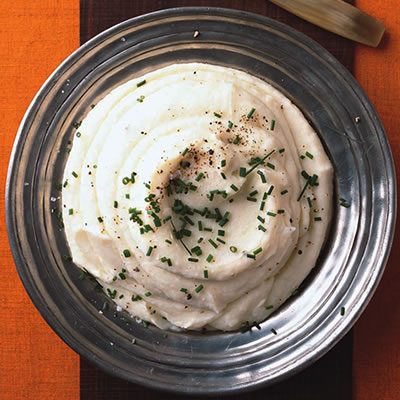A recent article in The New York Times offers a few recipes that are gluten-free.
From the article:
"When Silvana Nardone’s son Isaiah was diagnosed with gluten intolerance three weeks before Thanksgiving, the Brooklyn mom knew she faced a particularly challenging holiday meal. But as the owner of a bakery and founding editor of the food magazine Every Day With Rachel Ray, Ms. Nardone was up to the challenge.
Gluten is a protein found in wheat, rye and barley, so it can be challenge to cook without it. Ms. Nardone’s adventures in gluten-free cooking are documented in her new cookbook, “Cooking for Isaiah: Gluten-Free & Dairy-Free Recipes for Easy Delicious Meals.”
Gluten-Free Pumpkin Dumplings With Radicchio
Something to keep in mind when you make this recipe — it’s a lot easier than you think. The dumplings are super light and pillowy, but if you prefer a firmer texture, add more gluten-free flour, 1 tablespoon at a time, to the pasta dough.
1 15-ounce can pure pumpkin puree
2 large eggs, lightly beaten
1 cup store-bought gluten-free flour blend
Salt
2 tablespoons extra-virgin olive oil
1 medium onion, finely chopped
1/4 teaspoon crushed red pepper flakes
1 small head radicchio, sliced into 1/4-inch strips (about 2 cups)
2 tablespoons chopped fresh flat-leaf parsley
1. Bring a large pot of salted water to a boil. In a large bowl, combine the pumpkin puree, eggs, flour and 1 teaspoon salt to make the dough.
2. In a large saucepan, heat the olive oil over medium heat. Add the onion and red pepper flakes and cook until softened, about five minutes; remove from the heat and set aside.
3. When the water comes to a boil, use a teaspoon to scoop up the dough and form a dumpling, then carefully slide the dumpling off the spoon and into the boiling water. Continue forming dumplings until half the dough is used. Cook until the dumplings float, then simmer for about two minutes; remove with a slotted spoon and add to the saucepan with the onion. Repeat with the remaining dumpling dough.
4. Return the saucepan with the onion to medium-high heat. Toss in three-quarters of the radicchio and stir gently until just wilted, about two minutes; season with 1/2 teaspoon salt or to taste. To serve, divide the dumplings and sauce among four bowls and top with the remaining radicchio and parsley.
Yield: Serves 4.
Gluten-Free Apple-Pecan Cornbread Stuffing
Instead of toasting the cornbread, you can spread out the pieces on a baking sheet and let them sit on your counter top overnight, uncovered, to dry out.
Double Corn Cornbread:
1 cup rice milk
1 tablespoon apple cider vinegar
1 cup cornmeal, preferably medium grind
1 cup store-bought gluten-free flour blend
1/4 cup sugar
1 tablespoon baking powder
1 teaspoon baking soda
1 teaspoon salt
2 large eggs, at room temperature, lightly beaten
1/4 cup oil of choice
1 cup corn kernels (from about 1 ear of corn)
Stuffing:
2 tablespoons extra-virgin olive oil, plus more for greasing
1 small onion, chopped
2 stalks celery, thinly sliced
Salt
Pepper
4 cups Double Corn Cornbread (see recipe below), toasted and cut into 1-inch pieces
1 Granny Smith apple, peeled, cored and finely chopped
2 teaspoons dried herb blend, such as McCormick Italian Seasoning
1/2 cup chopped pecans
1. Prepare the cornbread. Preheat oven to 350 degrees Fahrenheit. Grease a 4 1/2-inch by 8 1/2-inch loaf pan. In a small bowl, stir together the milk and vinegar. In a medium bowl, whisk together the cornmeal, flour, sugar, baking powder, baking soda and salt. Stir in the milk mixture, eggs and oil until just blended; fold in the corn kernels. Pour the batter into the prepared pan.
2. Bake until golden and a toothpick inserted in the center comes out clean, about 45 minutes. Let cool completely in the pan set on a wire rack.
3. Prepare the stuffing. Preheat oven to 350 degrees. Generously grease an 8-inch square pan with olive oil. In a skillet, heat the olive oil over medium heat. Add the onion and celery and cook until softened, about five minutes; season with 1/2 teaspoon salt and 1/4 teaspoon pepper, or to taste.
4. In a large bowl, toss together the onion mixture, cornbread, apple and herb blend. Transfer to the prepared pan. Scatter the pecans on top and cover with foil; bake for 15 minutes. Remove the foil; bake until crispy and golden, about 20 minutes more.
Yield: Serves 6 to 8.
Isaiah’s Pumpkin Muffins With Crumble Topping
If you make these muffins around the holidays, stir a handful of dried cranberries or 1/4 cup chopped walnuts into the batter. You can also make pumpkin muffin tops with this recipe — just use a muffin-top pan and bake for about 10 minutes.
Topping:
1/4 cup store-bought gluten-free flour blend
1/4 cup packed light brown sugar
1/4 cup granulated sugar
1/2 teaspoon pumpkin pie spice
4 tablespoons all-vegetable shortening
Confectioners’ sugar, for sprinkling
Muffins:
1 3/4 cups store-bought gluten-free flour blend
2 teaspoons baking powder
2 teaspoons pumpkin pie spice
3/4 teaspoon salt
2 large eggs, at room temperature
1 cup canned pure pumpkin puree
1 cup granulated sugar
1/2 cup oil of choice
1 tablespoon pure vanilla extract
1. Preheat oven to 350 degrees Fahrenheit. Line a 12-cup muffin pan with paper liners.
2. Prepare the crumble topping. Whisk together the flour, brown sugar, granulated sugar and pumpkin pie spice in a medium bowl. Add the shortening and, using your fingers or a fork, blend together until coarse crumbs form.
3. To make the muffins: Whisk together the flour, baking powder, pumpkin pie spice and salt in a large bowl.
4. In a medium bowl, whisk together the eggs, pumpkin puree, granulated sugar, oil and vanilla until smooth. Add to the flour mixture; stir until just combined.
5. Fill each muffin cup almost full; top each with crumble topping. Bake until the muffins are springy to the touch and a toothpick inserted into the center comes out clean, 20 to 25 minutes. Let cool in the pan, set on a wire rack. Using a sieve, sprinkle with confectioners’ sugar.
Yield: 12 muffins.


















